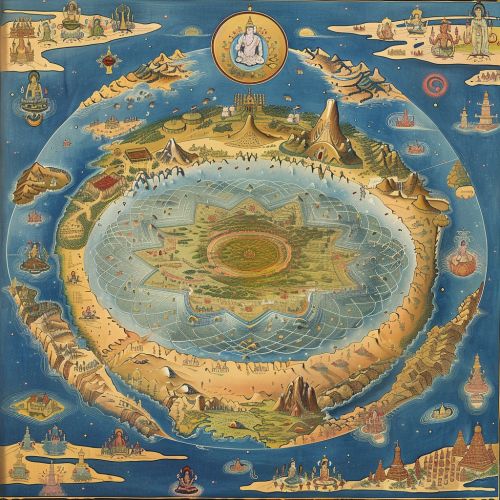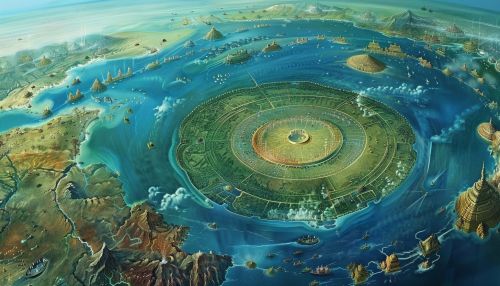Jambudvipa
Introduction
Jambudvipa is a term originating from ancient Indian cosmology, often interpreted as referring to the Indian subcontinent or the entire earthly plane of existence. The concept is found in various Hindu, Jain, and Buddhist texts, each with their own interpretations and descriptions. In these religious and philosophical systems, Jambudvipa is often depicted as the central realm among other realms or continents, each with its own unique characteristics and inhabitants.
Etymology and Meaning
The term "Jambudvipa" is derived from the Sanskrit words "Jambu," referring to the Jambu tree (Syzygium cumini), and "Dvipa," meaning island or continent. Thus, Jambudvipa can be translated as "the island or continent of the Jambu tree." The Jambu tree is known for its large size and the abundant, sweet fruit it produces, which are often associated with prosperity and fertility in Indian culture.
In Hindu Cosmology
In Hindu cosmology, Jambudvipa is described in various Puranas, including the Vishnu Purana and the Bhagavata Purana. According to these texts, Jambudvipa is the central dvipa (island or continent) of seven dvipas that constitute the earthly plane of existence. Each dvipa is surrounded by a distinct ocean, with Jambudvipa being surrounded by the ocean of salt water.
Jambudvipa is further divided into nine varshas or regions, each named after a son of the ancient king, Agnidhra. The central region, known as Ilavrita Varsha, is described as the most auspicious and is said to be the abode of Lord Shiva. The other eight varshas are said to be ruled by different demigods and are inhabited by various beings, including humans, celestial beings, and animals.


In Jain Cosmology
In Jain cosmology, Jambudvipa holds a similar position as the central continent but is described in more detail. The Jain Agamas and other texts describe Jambudvipa as being shaped like a man standing with his arms akimbo, with various regions and sub-regions.
Jambudvipa is said to be at the center of Madhyaloka, the middle part of the universe where humans and animals reside. It is surrounded by an ocean, beyond which lie the other continents. The inhabitants of Jambudvipa are subject to the cycle of birth and death, and it is only in this continent that beings can attain liberation or moksha.
In Buddhist Cosmology
In Buddhist cosmology, Jambudvipa is one of the four continents that surround Mount Meru, the central world-mountain. The concept is found in both Theravada and Mahayana texts, including the Jataka tales and the Avatamsaka Sutra.
In this context, Jambudvipa is often interpreted as representing the physical world where humans live. It is described as being located to the south of Mount Meru and is associated with the color blue or green. The inhabitants of Jambudvipa are said to have the most favorable conditions for attaining enlightenment, due to the balance of pleasure and suffering in this realm.
Conclusion
Jambudvipa, as a concept, offers a unique insight into the cosmological views of ancient Indian religions. While the interpretations vary, the term consistently represents the earthly realm of existence, often associated with the opportunity for spiritual growth and liberation. Despite its ancient origins, the concept of Jambudvipa continues to hold cultural and religious significance in contemporary Hindu, Jain, and Buddhist practices.
